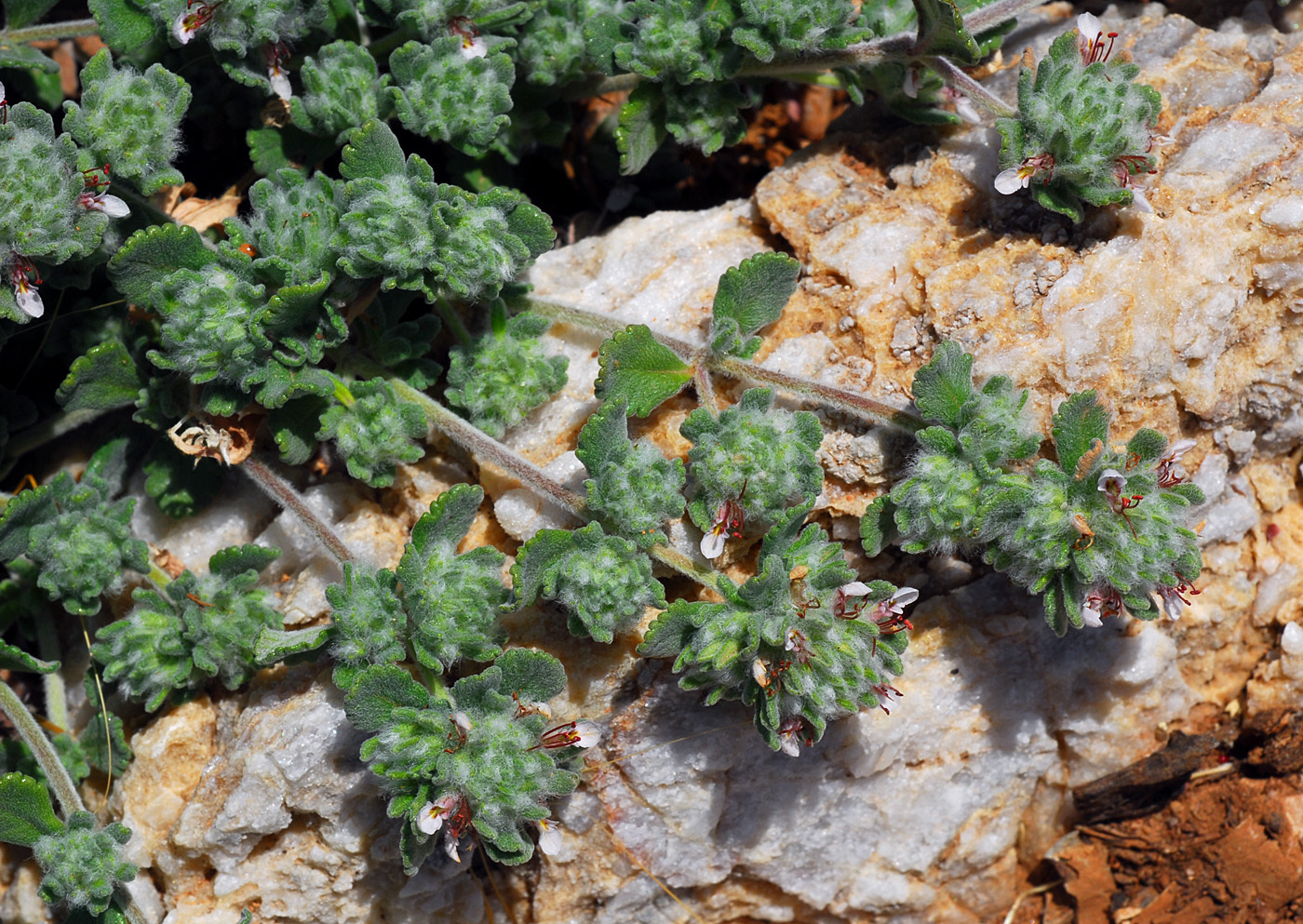Teucrium karpasiticum

Chromosome numbers
2n = 26A
A. Hadjikyriakou, G. & Hand, R. 2008: Notes on Teucrium sect. Polium (Lamiaceae) in Cyprus. – Willdenowia 38: 111-125
Distribution
Altitudinal range
0–50 mD
D. Hadjikyriakou, G. & Hand, R. 2008: Notes on Teucrium sect. Polium (Lamiaceae) in Cyprus. – Willdenowia 38: 111-125
Description
Much-branched subshrub forming low, intricate, diffuse or domed bushes 5-20 cm high; stems up to 25 cm long, greenish-brownish; old wood brownish to greyish, usually fissured. Current year's shoots of two kinds: (1) fertile shoots spreading or ascending, with a very dense indumentum of laxly adpressed or spreading, with age sometimes closely adpressed, crisped or non-crisped hairs, terete or subterete, at first simple, lengthening up to 15(-20) cm, each ending in a paniculate or corymbose inflorescence of capitula, occasionally capitula solitary and terminal; persisting, and becoming leafless, remaining white-hairy after the first year, with prominent leaf-scars; (2) sterile shoots born in the axils of the lower leaves of the fertile shoots, with the same indumentum, terete or subterete, lengthening usually up to 5(-10) cm, with closely arranged leaves and short internodes, remaining alive after the inflorescence of the fertile shoots becomes dry; short shoots bearing tufts of reduced leaves present in the leaf axiles of the fertile and sterile shoots. Leaves very shortly petiolate or subsessile; lamina 6-11(-18) × 3-8.5(-10) mm, variously shaped when fully open; lamina of the first spring leaves on the young fertile shoots larger, obovate-rhombic to almost orbicular, flattish with slightly recurved margins; lamina of the leaves appearing at a later stage usually obovate or oblanceolate, with strongly recurved or revolute margins; margins crenate in the upper third to half of the lamina, with 1-4(-6) crenations on each side and an apical tooth, in the lower, cuneate part entire or somewhat sinuate-undulate; upper surface dark green with white, adpressed, crisped, short or long hairs, with shining glands and with the median nerve usually prominently impressed and the lateral nerves prominently to slightly impressed; lower surface more densely white-tomentose, with shining glands and prominent nervation. Internodes on fertile shoots usually longer than the leaves; internodes of the sterile shoots usually shorter than the leaves and, chiefly in autumn and winter, very short and the very closely arranged leaves appearing tetrastichous. Flower heads (capitula) initially globose, usually lengthening with age, becoming cylindric or subcylindric, less often conical or subconical, 10-55 × (8-)10-13 mm; very rarely flower heads with very few flowers; commonly arising singly on short or long lateral shoots from the axils of cauline leaves forming generally lax paniculate or corymbose inflorescences, sometimes solitary at the top of the flowering shoots; axillary capitula-bearing shoots with lax, reduced leaves and occasionally with smaller axillary flower heads below the terminal elongate head. Flowers sessile, subsessile or with pedicels about 0.5 mm long, the lower progressively drying out as soon as new flowers arise at the top of the lengthening flower head. Bracts foliaceous, smaller than the leaves, narrowly oblanceolate, obovate, spathulate or ovate, flat or with recurved margins, 0.5-2 × 3 mm when fully open, about equalling or longer than the flowers; upper surface dark green, villose, with smaller glandular hairs and gland-dotted; lower surface more densely white-tomentose, with shorter glandular hairs and densely gland-dotted; margins sometimes with 1-2 pairs of small apical teeth, otherwise entire or subentire; apical tooth recurved. Bracteoles absent. Calyx tubular, (3.5-)4.2-5.5(-5.8) mm, slightly lengthening in fruiting stage to 5-5.6(-6.4) mm; tube 3-3.5 × 2-2.5 mm, 5-nerved, curved, gland-dotted and villoselanuginose, with shorter glandular hairs externally and sparse, short, subadpressed hairs internally; teeth somewhat unequal, hidden by hairs, gland-dotted and villose-lanuginose with shorter glandular hairs externally and up to some distance from the margins internally, except for the region of the veins with small glandular hairs only; abaxial teeth deltoid, somewhat acuminate, 0.8-1.3 × 0.7-1 mm, adaxial teeth about 0.8-1.2 × 1-1.5 mm. Corolla pink or purplish; external surface gland-dotted and thinly to densely pubescent above, glabrous at the lateral and basal lobes, subglabrous to glabrous towards the base; internal surface gland-dotted and thinly to densely pubescent at the throat, subglabrous to glabrous towards the base, glabrous at the median, lateral and basal lobes; tube 2.5-3.5 × 1.2-1.5 mm, slightly curved; limb 4-6 mm long, basal lobes semicircular, 0.8-1 × 0.8-1 mm, lateral lobes adpressed to the median lobe, oblong, c. (0.56-) 0.64-0.88(-1.04) × 0.4-0.56 mm, median lobe 1.5-2.5 × 1.5-1.7 mm, somewhat cucullate. Stamens inserted at mouth of corolla tube, exserted; filaments purple, thinly pilose, the adaxial two c. 2.5 mm long, the abaxial two c. 3.5 mm long; anthers purple, (0.5-)0.6-0.8 mm long. Ovary glabrous, c. 0.7-1 mm long; style glabrous, c. 5-6 mm long; stigmatic lobes subulate, subequal, 0.3-0.5 mm long. Nutlets somewhat cochleariform to obovate, c. 1.5 mm long, rounded at apex, wedge-shaped at base, dark brown to blackish, granulose, distinctly reticulately veined and foveolate, attachment area flat, suborbicular, c. 0.8 mm in diameter, adjacent to the attachment area convex.
Source: Hadjikyriakou G. & Hand R. 2008: Notes on Teucrium sect. Polium (Lamiaceae) in Cyprus. - Willdenowia 38: 111-125.
Source: Hadjikyriakou G. & Hand R. 2008: Notes on Teucrium sect. Polium (Lamiaceae) in Cyprus. - Willdenowia 38: 111-125.
